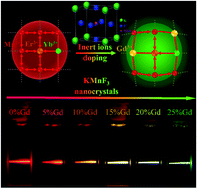Tuning the upconversion luminescence of cubic KMnF3:Yb3+/Er3+ nanocrystals through inert lanthanide ion doping†
Abstract
Multicolor lanthanide-doped upconversion nanoparticles have attracted extensive interest due to their application in biosensing, bioimaging, and therapeutics. Herein, a facile strategy of inert gadolinium or yttrium ion doping is proposed to implement tunable multicolor upconversion luminescence in a conventional single red emitting KMnF3 matrix through engineering the local crystal structure and controlling the energy exchanging transfer process. Variation of the Gd3+ or Y3+ doping content in the KMnF3:Yb3+/Er3+ lattice induces a gradual morphological transformation from cube to polyhedron, which arises from the increased lattice binding. The enlarged crystal cell size and the engineered local crystal structure enable the confinement of energy transfer as well as back transfer between Er3+ emitters and Mn2+ ions. Moreover, the partial replacement of Mn2+ ions by Gd3+ or Y3+ ions also weakens the intense interaction between Er3+ and Mn2+ ions. Based on the above functions caused by the precise control of the inert ion doping amount, a palette of multicolor UC luminescence shifting from red to green can be produced and immediately recognized by the naked eye. The results here provide the possibility of realizing simultaneous control of the physical dimensions as well as the luminescence properties of lanthanide-doped upconversion systems.



 Please wait while we load your content...
Please wait while we load your content...